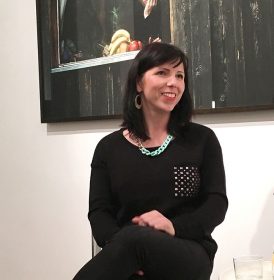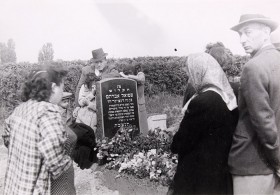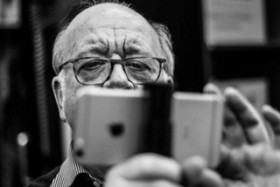Photo Portraits by Noga Shtainer

Noga Shtainer during an artist talk celebrating her show in Berlin in 2015 © Noga Shtainer
Noga Shtainer often travels with her camera in tow, for her photography project “Home for Special Children” in the Ukraine, for instance, or for “Twins” in Brazil. Shots from the latter project have been available for purchase from the art vending machine since 1 April 2016 (further information on our website). The photographer has lived since 2010 in Berlin, where I met her two years ago (I wrote about that encounter in a blog post in May of 2015).
The fact that Noga Shtainer is a photographer is itself accidental. She set out to become an actress. But she didn’t pass the entrance auditions for the WIZO School of Art in Haifa and was encouraged instead to apply for a photography class. The deadline for submitting an application portfolio was only two days away, however. → continue reading
The Tragic Fate of Shmuel Dancyger Z. L.

The family at the grave of Shmuel Dancyger; Jewish Museum Berlin, gift of Morris Dancyger
During a visit to my hometown of Calgary Alberta, Canada in the summer of 2014, I had the opportunity to meet with Morris and Ann Dancyger, both child survivors of the Holocaust. Morris Dancyger was one of the very few children to have been liberated by the Russians at Auschwitz on 27 January 1945. In the iconic footage of the children displaying their tattooed arms, four year old Morris is in the center of the picture. Ann Dancyger and her mother had miraculously survived an execution in 1942 near the town of Ratno where she was born, and spent nearly three years thereafter in hiding. After a nearly two year trek to Germany following the end of the war, she was able to come to Calgary where relatives lived. I had not known the Dancygers while growing up in the city, and although I had much later read about the tragic fate of Morris Dancyger’s father Shmuel, I was completely unaware that his wife and children had settled in Calgary. → continue reading
A Guest Entry by Rudij Bergmann
Accompanying our current exhibition, “No Compromises! The Art of Boris Lurie,” Rudij Bergmann’s film about the artist will premiere on 21 March 2016 (additional information available on our event calendar). In this guest entry, the filmmaker tells us how this very personal documentary came about.
The artist’s longing for Europe was palpable from the moment I first saw him in the dim light of an apartment hallway on New York’s 66th Street. Stepping into his home studio, confronted by this breathtaking collage of memory, it was immediately clear to me that Boris Lurie hadn’t fully left the concentration camps he survived with his father – at least mentally.
It was October 1996. A film for the television magazine BERGMANNsART, which I’m for all intents and purposes responsible for, was the reason to rush to see Lurie in New York. (The film, in German and with age restriction, is available on YouTube.)
It was the beginning of a long friendship. → continue reading


